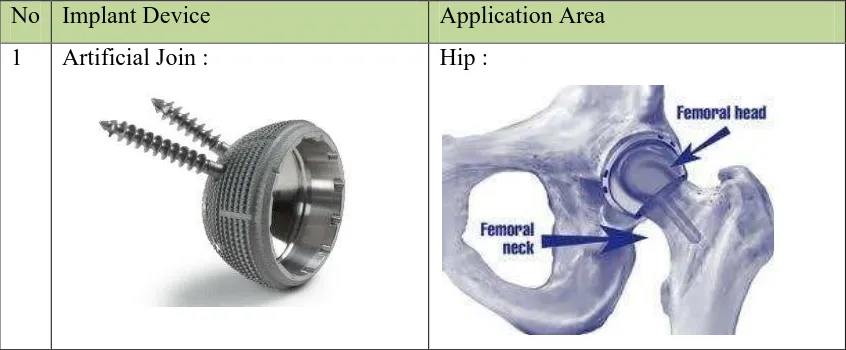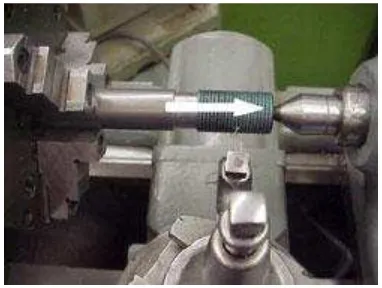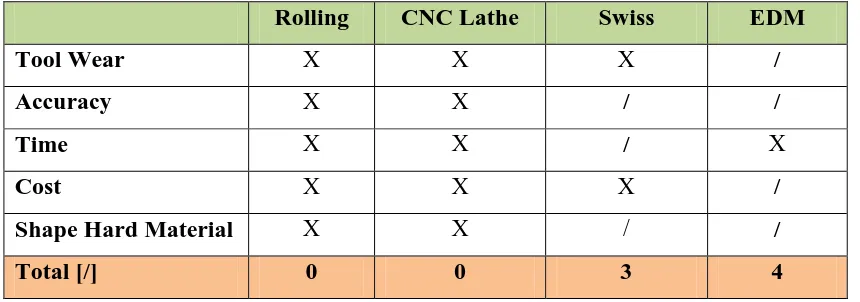UNIVERSITI TEKNIKAL MALAYSIA MELAKA
NOVEL EDM THREAD WHIRLING TECGHNIQUE FOR ORTHOPEDIC
MEDICAL SCREW IMPLANT APPLICATION
This report submitted in accordance with requirement of the Universiti Teknikal Malaysia Melaka (UTeM) for the Bachelor Degree of Manufacturing Engineering
(Manufacturing Process)(Hons.)
by
MUHAMMAD FAQRUL REDUAN BIN ABDUL MAJID
B 050910230
880224-02-5185
UNIVERSITI TEKNIKAL MALAYSIA MELAKA
BORANG PENGESAHAN STATUS LAPORAN PROJEK SARJANA MUDA
TAJUK: Novel EDM Thread Whirling Technique for Orthopedic Medical Screw Implant Application
SESI PENGAJIAN: 2012/13 Semester2
Saya MUHAMMAD FAQRUL REDUAN BIN ABDUL MAJID
mengakumembenarkanLaporan PSM ini di simpan di Perpustakaan Universiti Teknikal Malaysia Melaka (UTeM) dengan syarat-syarat kegunaan seperti berikut: 1. Laporan PSM adalah hak milik Universiti Teknikal Malaysia Melaka dan penulis. 2. Perpustakaan Universiti Teknikal Malaysia Melaka dibenarkan membuat salinan
untuk tujuan pengajian sahaja dengan izin penulis.
3. Perpustakaan dibenarkan membuat salinan laporan PSM ini sebagai bahan pertukaran antara institusi pengajian tinggi. atau kepentingan Malaysia sebagaimana yang termaktub dalam AKTA RAHSIA RASMI 1972)
(Mengandungi maklumat TERHAD yang telah ditentukan oleh organisasi/badan di mana penyelidikan dijalankan)
(TANDATANGAN PENULIS)
AlamatTetap:
Lot 44, Kg. Solok Bangsal, Pantai Belimbing, 76100
DECLARATION
I hereby, declared this report entitled “Novel EDM Thread Whirling Technique for Orthopedic Medical Screw Implant Application” is the results of my own research
except as cited in references.
Signature : ……….
Author’s Name : MUHAMMAD FAQRUL REDUAN BIN
ABDUL MAJID
APPROVAL
This report is submitted to the Faculty of Manufacturing Engineering of UTeM as a partial fulfillment of the requirements for the degree of Bachelor of Manufacturing Engineering (Manufacturing Process) (Hons.). The member of the supervisory is as follow:
i
ABSTRACT
ii
ABSTRAK
Kerana gabungan cemerlang kekuatan, modulus yang rendah dan ketahanan kakisan yang tinggi. Aloi Titanium semakin digunakan sebagai bahan perubatan. Titanium digunakan terutamanya dalam aplikasi kecederaan ortopedik, seperti patah tulang yang memerlukan penetapan skru. Walau bagaimanapun, reka bentuk geometri yang rumit dan toleransi ketat skru ortopedik menghadkan teknik fabrikasi itu. Secara umumnya, kekuatan skru ortopedik telah direka menggunakan satu titik bebenang dan teknik berpusing benang. Walau bagaimanapun, terdapat beberapa pernemuan masalah dengan menggunakan teknik-teknik seperti kaedah kakisan pantas, fleksibiliti reka bentuk terhad, ketepatan yang rendah dan kos modal yang tinggi. Kaedah yang sesuai untuk mengatasi masalah ini adalah dengan menggunakan mesin pelepasan elektrik proses di mana bahan yang dikeluarkan oleh hakisan percikan elektrik. Kerana tidak ada hubungan fizikal antara elektrod alat dan bahan kerja, kadar kakisan alat adalah rendah dan kekerasan bahan-bahan yang tidak bergantung. Di samping itu, kelebihan utama menggunakan teknik EDM adalah ketepatan dan mencari integriti permukaan yang sesuai untuk aplikasi perubatan. Walau
iii
DEDICATION
iv
ACKNOWLEDGEMENT
A special thanks to my supervisor, Dr. Raja Izamshah Bin Raja Abdullah for this supervision in doing this project. I greatly appreciate his consistent encouragement, advice and invaluable guidance throughout the project.
I wish to extend my special appreciation to Mr. Hanafiah and Mr. Taufik as technicians for their patience, support and comment.
v
List of Abbreviations, Symbols & Nomenclature xi
CHAPTER 1: INTRODUCTION 1
1.1 Background of Study 1
1.2 Orthopedic Medical 3
1.2.1 Material For Bone Screw 4
1.2.1.1 Titanium Alloys 4
1.2.2 Medical Implant Device From Titanium 5
1.3 Current Methods for Fabricating Titanium Screw 6
1.4 Objective 9
2.4 EDM Parameter (Recommendation) 16
2.5 Summary of The Chapter 17
CHAPTER 3: METHODOLOGY 18
vi
3.1.1 Framework 19
3.2 Product Design (CAD) 20
3.3 Fabricate Electrode 21
3.3.1 Method A : Machining 22
3.3.1.1 Electrode Design (CAD) 22
3.3.1.2 Electrode Manufacture (CAM) 23
3.3.2 Method B : Reverse 23
CHAPTER 4: RESULT AND DISCUSSION 27
4.1 Process Selection Method 27
4.1.4 Seek Supporting Information 37
4.1.5 Final Process Choose 37
4.2 Statistical 37
4.2.1 Data Collected From Experiment 37
vii
4.2.3.1 Design (Actual) 45
4.2.3.2 Analysis 47
4.2.3.3 Optimization 48
4.3 Final Selection Method 49
CHAPTER 5: CONCLUSION AND RECOMMENDATION 51
5.1 Conclusion 51
5.2 Recommendation 52
5.2.1 More Analysis Method Are Used 52
5.2.2 Implement Using Other Workpiece or Electrode Material 52
5.2.3 Suggestion for Further Study 52
REFERENCES 54
APPENDIX
A Gantt Chart PSM 1 & 2 B Flow Chart PSM
viii
LIST OF TABLES
1.1 Application screw on medical part 2
1.2 Mechanical characteristics of metal alloys use in medical implant 5 1.3 Comparison capability of machine in fabricating titanium material 8 1.4 Number of the capabilities of fabricating titanium material [/] 8 2.1 Composition of Ti-6Al-4V (mass-friction, %) [11] 10
2.2 Physical performance of Ti-6Al-4V [11] 10
2.3 Experimental setting [10] 14
2.4 Experimental setting [11] 14
2.5 EDM parameter (theoretical) 16
4.1 Design Requirement 28
4.2 Rank Table 36
4.3 Electrode / Tool Wear, g 38
4.4 Dimension Error, % 38
4.5 Machining Time for Electrode 38
4.6 Machining Time By Part for Method A 39
4.7 Machining Time By Part for Method B 39
ix
LIST OF FIGURES
1.1 Requirement of implant 4
1.2 Rolling machine in fabricating screw 6
1.3 Lathe machine fabricating screw 6
1.4 Swiss lathe comparison between conventional thread and thread whirling 7
2.1 Design of standard and orthopedic screw 11
2.2 Parameter of bone screw 12
2.3 Cortical screw [8] 13
2.4 Cancellous screw [8] 13
2.5 Relation between electrode and pulse interval [11] 15 2.6 Relation between electrode and capacitance [11] 15
3.1 Framework 19
3.7 Tapping Process Used Tapper Bit (Manually) 24
4.1 A Flow Chart of The Procedure for Process Selection [15] 27
4.10 Graph for Electrode / Tool Wear During Fabricating Electrode 40
4.11 Graph for Dimension Error, % for Screw Size 41
4.12 Graph Machining Time for Produce Electrode 43
x
4.14 Design Summary 46
4.15 Design Graph 46
4.16 Analysis Report of Wear 47
4.17 Analysis Report of Error 48
xi
LIST OF ABBREVIATIONS, SYMBOLS & NOMENCLATURE
PSM - Projek Sarjana Muda
CNC - Computer Numerical Control EDM - Electric Discharge Machine MRR - Material Removal Rate EWR - Electrode Wear Rate
SR - Surface Roughness
TWR - Tool Wear Rate
CAD - Computer Aided Design
CAM - Computer Aided Manufacturing
% - Percentages
A - Ampere
µs - Micro Second
V - Voltage
g - Gram
1 This chapter is the introductory section of the report. It contains the overview, background, problem statement, objectives, and scope of the study.
1.1 Background of Study
Increasing demand for bone screws, implants and other micro-components creates a
need for new techniques that produce specific thread forms quickly and with high
tolerances. The hard outer shell and a softer, almost sponge-like core of the human
bone requires bone screws to be hard and sharp enough to penetrate the outer shell,
without the thread form separating from the soft core (Table 1.1). In addition, the
competitive market of bone screw design sees manufacturers change their thread
profiles every two to three years, with each profile coming in four different screw
designs. A bone screw can be as unique as the human bone it penetrates, and in some
cases is designed personally by an orthopaedic surgeon for their patient.
Available in any number of lengths and diameters in standard and custom
designs, bone screws tend to have a high aspect ratio, requiring the need for special
support devices during manufacture when using the traditional single-point threading
tool. Bone screws also have deep threads, requiring many short cuts to be made,
which is a slow process that leads to shorter tool life and is worsen when in many
cases for medical application the material is from exotic material typically titanium
alloys. Another fundamental limitation associated with using a single threading cutter
for machining bone screws is the limited helix angle of only seven degrees. Modern
INTRODUCTION
2
screws are designed with helix angles up to 20 degrees. These drawbacks led the
medical industry to shift from single-point threading tools to thread-whirling for the
production of bone screws.
Thread whirling is a type of thread milling process in which the cutter edges
of the tool reside on the inside of the cutter ring rather than the outside. The entire
threading operation is performed in a single pass, typically using a thread whirling
attachment on a sliding head machine. Other steps in the screw manufacturing
process is turning of the front and back of the screw head, drilling of the head, and
clearance turning of the hole bottom using the thread whirling attachment. However,
since this technique requires a physical contact the tool wear cannot be avoid.
The suitable candidate to overcome this problem is using electrical discharge
machining process in which the material is removed by spark erosion. Since there is
no physical contact between tool electrode and workpiece, the tool wear rate is low
and the material hardness is not dependent. In addition, the main advantages of using
EDM technique are the component accuracy and fine surface integrity which is
suitable for medical application.
Table 1.1: Application screw on medical part.
No Implant Device Application Area
3
2 Knee plate : Knee :
3 Spinal plate : Spine :
1.2 Orthopedic Medical
4
1.2.1 Material for Bone Screw.
The material used in medical bone screw called biomaterials. In general material used in medical application, can be categorize into three such as metallic, ceramic and polymeric materials. The material contain in biomaterials must follow the mechanical properties for medical implant called biomechanical properties. The properties are biocompatibility, bioadhesion, biofuctionnality, and corrosion resistance as medical implant relate with human body, human tissues and human sensitivity [1].
Figure 1.1: Requirement of implants [2].
1.2.1.1 Titanium Alloys
Titanium is one of the material listing in biomaterial group. Titanium is under group metallic biomaterial. Another material in metallic biomaterial is stainless steels, and cobalt alloys. Compare with another two material, titanium alloys is the best material because titanium has good biomechanical properties. Titanium alloys is low in specific gravity and good corrosion resistance. This two biomechanical properties are importance when the patient has more than one implant and the surgery take long time or surgeon operates used the surgical tool for a long time [3].
5 biocompatibility and low in stiffness. Titanium also has better tissue tolerance compare with other two materials [1].
Table 1.2: Mechanical characteristics of metal alloys use in medical implant [1].
1.2.2 Medical Implant Device from Titanium.
Mostly grade Titanium used in medical is Ti-6Al-4V. The material is combination of 6% Aluminum and 4% Vanadium. This material mostly used because of its harmonizing factor with the human body.
From the listing material in biomaterials group, Titanium Alloys is main material used for device medical implant applied on artificial joint, bone plate, screw, spinal, and other part in human body [1].
Medical grade titanium is used in producing: a) Pins
6 The important part is screw because most part produces from Ti-6Al-4V will attach with screw to apply on disease area.
1.3 Current Methods for Fabricating Titanium Screw
Generally, for typical and high volume screw production, rolling machine is used. However the rolling machine produces parts with high tolerance and low part accuracy which affect the product quality. Which not suitable for medical application.
Figure 1.2: Rolling machine in fabricating screw.
As an alternative to overcome the disadvantages in rolling machine CNC Lathe are used for fabricating screw. However, number of published work [4, 5] reported that the tool wear rate is high when turning the titanium workpiece. Diamond tool is always employed for turning the titanium workpiece which increase the cost because the diamond has the highest hardness and highest heat conductivity among the substances and is excellent in chemical stability [6].
7
Another fundamental limitation associated with using a single threading cutter for
machining bone screws is the limited helix angle of only seven degrees. Modern
screws are designed with helix angles up to 20 degrees. These drawbacks led the
medical industry to shift from single-point threading tools to thread-whirling for the
production of bone screws. The advantages of single point threading tools has led to the application of thread whirling by using a Swiss machine.
In process to produce Bone screw, the major machine used is Swiss machine. Conventional threading operations on Swiss lathe able in multiple threading cuts by using a single point tool. This machine is the better machine in produce long screws. As shown in figure 1.2, Swiss lathe used with whirling cutter. Whirling cutter rotates at a high speed while bar stock rotates at a low speed. Whirling cutter improve quality and productivity.
Figure 1.4: Swiss lathe. comparison between conventional thread and thread whirling.
The machine also a fast method, due to using six inserts in the milling cutter and ideal for difficult materials while eliminating chip problem. The process using a Swiss machine is very expensive.
8 The study will propose a new method in producing bone screw. The new method is producing bone screw using Electric Discharge Machine (EDM) Die Sinking. This new method or suggest base of the problem happen on the previous machining like a tool ware, and expensive production cost. The non-physical contact on EDM will used for solution on tool ware and EDM machining not too expensive. The new method also for the problem of current process in machining hard material.
The suitable candidate to overcome this problem is using electrical discharge
machining process in which the material is removed by spark erosion. Since there is
no physical contact between tool electrode and workpiece, the tool wear rate is low
and the material hardness is not dependent. In addition, the main advantages of using
EDM technique are the component accuracy and fine surface integrity which is
suitable for medical application.
Table 1.3: Comparison capability of machine in fabricating titanium material.
Rolling CNC Lathe Swiss EDM
Table 1.4: Number of the capabilities of fabricating titanium material [/].
9
1.4 Objectives
Both the difficulties and disadvantages for fabricating Titanium Screw were causing to initiate this project.
a) To design a new concept for fabricating electrode using EDM Sinker on producing bone screw.
- The study was conducted to solve the problem in current machining used for fabricating bone screw.
b) To provide an alternative process for screw thread fabrication method.
- The study was conducted based on the suggested method for producing the electrode used for EDM Die Sinking to machining the titanium alloy.
c) To identify the capability of EDM Die sinking in produces the screw. - The comparison was made based on a screw produce by the current machine and the screw produce by using EDM Die Sinking.
1.5 Scope of Project

![Figure 1.1: Requirement of implants [2].](https://thumb-ap.123doks.com/thumbv2/123dok/543453.63451/19.595.120.523.282.436/figure-requirement-of-implants.webp)
![Table 1.2: Mechanical characteristics of metal alloys use in medical implant [1].](https://thumb-ap.123doks.com/thumbv2/123dok/543453.63451/20.595.116.527.155.257/table-mechanical-characteristics-metal-alloys-use-medical-implant.webp)


